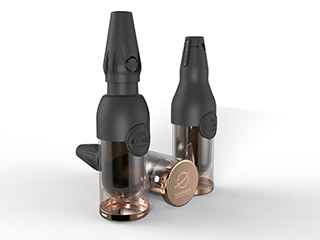 |
| Vostok Space Beer Bottle |
Is it time for Craft beer to move into the final frontier? An Australian partnership believes so. 4 Pines Brewing and Saber Astronautics have partnered to design both a bottle for use in space, and a beer to suit the pallet of zero g drinkers. They call it Vostok Space Beer, honoring the craft that sent Yuri Gregarin into space, and launched a million dollar IndieGoGo campaign earlier this week. Interest seems low.
The striking bottle design by Angelina Kwan is named "Dark Side of the Moon". It's highly stylized and would fit better on the set of Star Wars than 2001: A Space Odyssey. Space age design elements are cool. I love to see increased use of scientific motifs in design, even if it's not hyper realistic. The PR photos are designed with the commemorative market in mind, and have a nice detachable glass at the bottom.
The technological design brief is to find an artful way to move liquid from storage to the drinker. The Vostok project is committed to the long neck bottle as we know it. That means no plungers. No tooth paste tubes. Nothing that could have been in a cosmonaut's pantry. The idea in this design is to use the beer's surface tension to wick the beverage from the bottle to the outlet, on demand. All of the technology is hidden in the black top of the bottle. Similar techniques are applied to fuel tanks, to manage the risk of bubbles causing troubles. It should work. Most likely, the space version of the bottle would be glass free and built with slightly less photogenic polycarbonate or polypropylene .
I'm not sure the commitment to the bottle is necessary. It's not like bottle drinking is a celebrated part of the terrestrial craft beer experience. However, I have to admit that the design is great for publicity.
 |
| Ecofass plastic keg and disposable bag |
Presently, carbonated beverages aren't really consumed in space. They have a potential to get really messy. The vostok bottle may reduce the risk. It might need a handle in practice. Most likely, beer won't be officially consumed in space until artificial gravity is built into space ships and stations. At this point, the closed container becomes less necessary and ultimately detrimental. It will be key to reduce packaging weight per unit volume. That will drive towards personal bags and casks for group consumption. The risks associated with CO2 tanks to drive keg beer seem to outweigh the benefits. Space beer will be stouts, porters and British styles. The 4 pines guys are on to something here. In space, light lagers will be flat and relatively tasteless
I'd like to comment on the beer reformulation, but i can't find evidence about what would differ from the terrestrial 4 pines stout. Anyone who has flown on a long haul flight can attest that nothing tastes quite right at altitude. Airlines spend considerable effort selecting wines that have some flavor in the air. I wish they'd dedicate similar efforts to the beer.
So say we all!
Comments